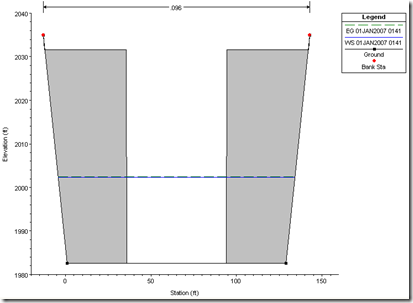
Full Momentum Episode 37: All Things Gates
Gates play a crucial role in hydraulic modeling, impacting water flow, flood control, and dam operations.
Just ran into an interesting phenomenon. I was running a dam breach model with fairly typical breach parameters and piping failure mode. After the peak of the breach hydrograph, there appeared a mysterious “spike” as shown in the figure below.

This happens to be right at the same time the flow through the developing breach becomes freeflowing (as opposed to pressure flow through the breach opening) as shown in the next two figures.


This is the point at which RAS switches from using the orifice equation to the weir equation. The breach editor allows you to specify a breach weir coefficient. By lowering this weir coefficient, you can get rid of the spike and have a smoother hydrograph. I’m not concluding that this spike is incorrect. In fact, it is quite possible that you do experience a real surge when the breach collapses in and goes freeflowing. In that case, you may find the spike acceptable. Whichever result you use, be sure you can back it up with sound reasoning. Given the extreme uncertainty in both breach weir coefficients and piping coefficients, it’s probably best that you run a sensitivity analysis to gain a full understanding ot the effects these coefficients have on the dam breach hydrograph.
Breach weir coefficient = 3.0

Breach weir coefficient = 2.0

Breach weir coefficient = 1.0

Looks like a breach weir coefficient of 1.0 does the trick.
Comments
Gary Brunner
on October 16, 2012The spike is more correct than no spike. It represents the fact that it is going from pressure flow (during the piping failure) to open channel flow (when the top of the pipe caves in). In general when the top of the pipe caves in there will be an increase in the flow rate (unless it does not cave in untill the water is already below the top of the pressure flow lid). So insteady of trying to predict a weir coefficient that smooths out the flow hydrograph, I would pick a weir coefficient that I think is appropriate for flow going through the breach when it is open channel flow (I.E. THE WEIR EQUATION IS BEING USED). In general for most breaches, I would say the assumption of a broad crested weir is the closest to what happens with an earth dam, so I would use 2.6 for the weir coefficient.
Chris G.
on October 16, 2012Good point Gary. Thanks for the comment. When doing a sensitivity analysis on the breach discharge coefficient, what would you say is a good range to bracket around the 2.6? I usually do 2.0 to 3.0, which, by the way, is not supported by anything but my own intuition.
Vinícius
on January 23, 2013Can someone to have a tutorial of dam break analysis ?
Chris G.
on February 7, 2013I'm not aware of a published tutorial that is available, other than what is in the HEC-RAS manuals. WEST Consultants offers a Dam Breach Analysis Class http://www.westconsultants.com/training. In fact, I'm teaching it in San Francisco as I type this!
Add Your Comment